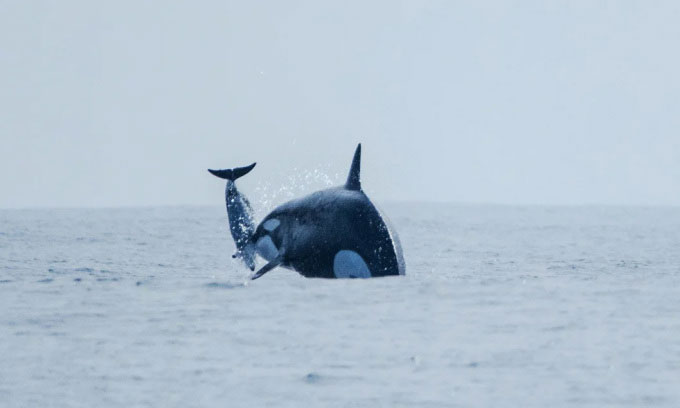Killer whale tosses dolphin into the air
Scientists have filmed killer whales attacking smaller dolphins, taking down their prey and sharing meals with their mates.
New research published in the journal Frontiers in Marine Science on September 26 reveals the behavior of a mysterious group of killer whales that scientists do not fully understand.

During a hunt, a killer whale (right) tosses a dusky dolphin (left) out of the water. (Photo: Maikol Barrera).
In 2023, off the coast of Chile, a large female killer whale attacked a smaller dolphin, tossing it out of the water. Within minutes, the unequal battle was over and the predator was ready to tackle its prey. But she wasn't eating alone. While she held the dolphin, other killer whales swam in to join her in the feast.
A team on a nearby boat filmed the meal and identified the prey as a dusky dolphin ( Lagenoryhnchus obscurus ) , a small porpoise native to South America that lives close to shore. This is the first evidence that killer whales in the Humboldt Current system — a Pacific ocean current that flows north along the west coast of South America — hunt and co-predate dusky dolphins.
Killer whales ( Orcinus orca ) are found worldwide. They are divided into several 'ecotypes' – groups that share similarities in appearance and behavior, including hunting strategies and preferred prey. There are five ecotypes in the Northern Hemisphere and five ecotypes in the Southern Hemisphere. However, the Humboldt Current killer whale has not yet been classified into an ecotype.
Scientists know very little about the habits of the Humboldt Current killer whale . In the Humboldt Current, cold, nutrient-rich water swirls up from the deep sea, feeding anchovies and crustaceans. These are then eaten by larger marine mammals such as dolphins and seals. Dolphins and seals, in turn, are preyed upon by killer whales.
Killer whales share a meal of a dark dolphin. (Photo: Luis Aguilar/CETALAB).
In the new study, lead author Ana Maria García Cegarra, an associate professor at the Alexander von Humboldt Institute of Natural Sciences at the University of Antofagasta in Chile, focused on killer whales in the Humboldt Current. She and her colleagues looked closely at records from 2011 to 2023 in the Humboldt Penguin National Reserve and around the Mejillones Peninsula. They also conducted ship surveys in Mejillones Bay and filmed killer whales with drones.
The dusky dolphin is about 2m long and weighs 85kg. Meanwhile, the killer whale is up to 10m long and can weigh 10 tons. According to new research, the Humboldt Current killer whale eats not only dolphins but also leatherback turtles, South American fur seals and Humboldt penguins.
Monitoring the Humboldt Current killer whales and knowing what they hunt and eat would be very useful for conservation organizations. The group is listed as 'data deficient' on the Red List of the International Union for Conservation of Nature (IUCN) and the Chilean Ministry of Environment, according to García Cegarra. As a result, there are currently no clear management tools or strategies to protect them.
"Killer whales play a vital role in the world's oceans and they are valuable in their own right. The more we learn about killer whales, the better we can protect the waters they inhabit," said Sarah Teman, a graduate student at the University of Washington's School of Fisheries and Aquatic Sciences.
- The chaotic dolphin fled when the killer whale ambushed
- The killer whale finally gave up the corpse after 17 days floating in the ocean
- 'Ocean killer' hunts penguins
- Why do dolphins ride on whale's backs?
- The secret of the killer whale
- That's good fighting, but killer whales succumb to these gentle 'guardians'
- Aquaculture dolphin and whale teeth
- Killer whale mother and child team up to drown their fellow killer whales
- A herd of killer whales joined forces to sink a 15m long yacht
- Whale fossils are located in ancient killer whales
- 'Grandma effect' in killer whales
- Video: Sharks and sea wolves are in great fire
 Surprised: Fish that live in the dark ocean still see colors
Surprised: Fish that live in the dark ocean still see colors Japan suddenly caught the creature that caused the earthquake in the legend
Japan suddenly caught the creature that caused the earthquake in the legend A series of gray whale carcasses washed ashore on California's coast
A series of gray whale carcasses washed ashore on California's coast Compare the size of shark species in the world
Compare the size of shark species in the world Name some of the most ferocious 'queens' in the animal world
Name some of the most ferocious 'queens' in the animal world  Tactics that help killer whales hunt the largest fish on the planet
Tactics that help killer whales hunt the largest fish on the planet  Killer whales carrying dead salmon leave scientists baffled
Killer whales carrying dead salmon leave scientists baffled  Killer whales knock seabirds out of the water
Killer whales knock seabirds out of the water  Decoding the reasons why killer whales attack ships
Decoding the reasons why killer whales attack ships  A herd of killer whales joined forces to sink a 15m long yacht
A herd of killer whales joined forces to sink a 15m long yacht 